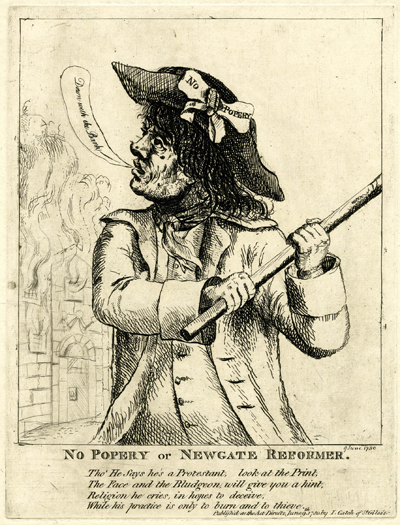No Popery, or Newgate Reformer
No Popery. . . purports to show one of the participants in the infamous Gordon Riots which raged across London from June 2 to June 7, 1780. He wears the blue cockade of the No Popery movement, but he is wielding a bludgeon and standing before a flaming Newgate Prison (which had been set ablaze on Tuesday evening, June 6th) and is calling for a similar destruction of the Bank.

© Trustees of the British Museum
The Gordon riots began as a rowdy but peaceful march to Parliament led by Lord George Gordon of the Protestant Association to present a petition demanding the repeal of the recent Papists Act which loosened some of the long-standing restrictions upon Roman Catholics. To Gordon and the members of the Protestant Association, any concessions to Roman Catholics were a slippery slope to absolute monarchy, rule by the pope in Rome, and the dissolution of English freedoms. So there were already heightened emotions to start with.
But when the Commons overwhelmingly dismissed Gordon's petition, the assembled mob began to take matters into their own hands. First they began to attack Catholic chapels and the homes of prominent Catholics. But as the numbers, anger, and recklessness of the mob increased, the initial violence against papists soon spread beyond that to figures of authority, especially those belonging to the penal system. Chief Justice Lord Mansfield, the Bow Street Magistrate John Fielding, Justice David Wilmot—all had their houses set on fire. And it was only a matter of time before the principal symbols of the penal system, the prisons themselves were attacked. This included the infamous Newgate prison, Fleet Prison, and the Clink, none of which had anything to do with the initial Catholic/Protestant tensions. Indeed, the ultimate targets and extent of the final destruction support Gillray's point in the verses beneath the image:
Tho' He says he's a Protestant, look at the Print,
The Face and the Bludgeon will give you a hint,
Religion he cries, in hopes to deceive,
While his practice is only to burn and to thieve.
Gillray signs the print as I. Catch which can suggest his satiric skill in exposing the true motives behind this figures' actions. But it can also allude to Jack Ketch, the infamous executioner, who caught up with many such criminals.
Sources and Reading
- Commentary from the British Museum on No Popery, or Newgate Reformer
- "Gordon Riots," Wikipedia
- Hitchcock & Shoemaker, London Lives,
- "Newgate Prison," Wikipedia
- "Jack Ketch," Wikipedia
- "St Giles, London," Wikipedia
Comments & Corrections
NOTE: Comments and/or corrections are always appreciated. To make that easier, I have included a form below that you can use. I promise never to share any of the info provided without your express permission.